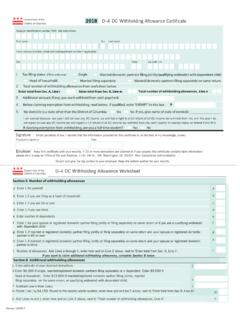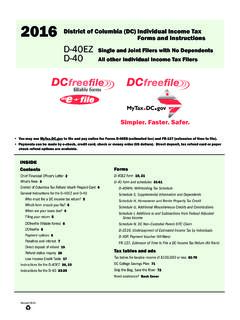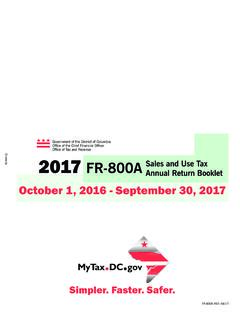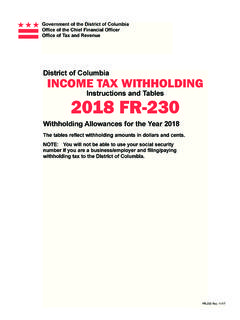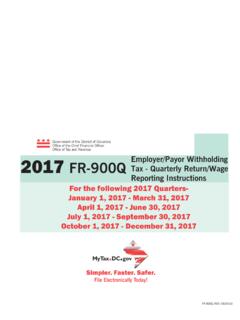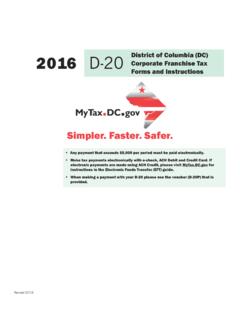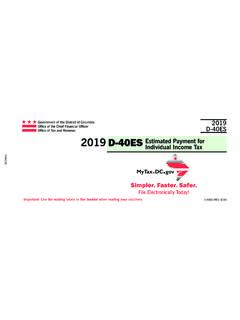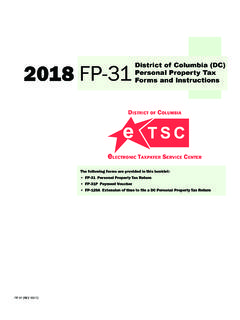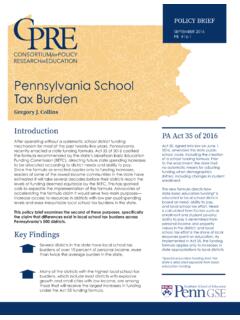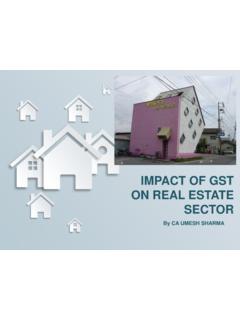Transcription of Tax Rates and Tax Burdens - Office of Tax and Revenue
1 Government of the District of Columbia Natwar M. Gandhi Chief Financial Officer Tax Rates and Tax Burdens in the District of Columbia - A Nationwide Comparison 2009. Issued September 2010. Tax Rates and Tax Burdens in the District of Columbia: A Nationwide Comparison Table of Contents Listing of Major Tables .. iii Executive Summary ..v Acknowledgment .. vi Part I: Tax Burdens in Washington, Compared with Those in the Largest City in Each State, 2009. 1. Chapter I How Tax Burdens are Computed for the Largest City in Each 2. Individual Income Tax .. 3. Real Property Tax .. 5. Sales and Use 6. Automobile Taxes .. 6. Chapter II Overall Tax Burdens for the Largest City in Each 7. Chapter III Comparing Specific Tax Burdens for a Hypothetical Family of Three in the Largest City in Each 14.
2 Individual Income Tax .. 14. Real Property Tax .. 16. Sales and Use 21. Automobile Taxes .. 23. i Tax Rates and Tax Burdens in the District of Columbia: A Nationwide Comparison Table of Contents Chapter IV How Do Tax Burdens in Washington, Compare with Those in the Largest City in Each State?.. 26. Individual Income Tax .. 26. Real Property Tax .. 27. Sales 27. Automobile Taxes .. 28. Summary .. 28. Chapter V Why Do Tax Burdens Differ from One City to Another? .. 30. Part II: A Comparison of Selected Tax Rates in the District of Columbia with Those in the 50 States as of January 1, 2010. 33. Appendix 53. Office Locations and Telephone Numbers .. 56. ii Listing of Major Tables Part I: Tax Burdens in Washington, Compared with Those in the Largest City in Each State, 2009.
3 Table 1 Estimated burden of Major Taxes for a Hypothetical Family of Three, 8. Table 2 States that Index Some Part of Their Individual Income Tax, 2009 .. 15. Table 3 Income Tax burden as Percent of Income in the Largest Cities by Type of Income Tax for a Family of Three, 2009 .. 17. Table 4 Residential Property Tax Rates in the Largest City in Each State, 2009 .. 18. Table 5 Housing Value Assumptions, 19. Table 6 Cities That Allow Exemptions or Reduced Rates in the Calculation of Real Estate Taxes for Homeowners, 2009 .. 20. Table 7 State and Local General Sales Tax Rates in Each of the 51 Cities as of December 31, 22. Table 8 Gasoline Tax Rates in the 51 Cities as of December 31, 24. Table 9 Summary of Types of Automobile Registration Taxes, 2009.
4 25. Table 10 Automobile Tax Assumptions, 2009 .. 25. Table 11 Tax Burdens in Washington, for a Hypothetical Family Compared with the Average for the Largest City in Each State by Income Class, 29. Table 12 The Largest City in Each State .. 32. iii Listing of Major Tables Part II: A Comparison of Selected Tax Rates in the District of Columbia with those in the 50 States: As of January 1, 2010. Table 13 Comparison of Selected State Tax Rates .. 33. Table 14 Individual Income Tax: Washington Metropolitan Area, January 1, 2010 .. 34. Table 15 Individual Income Tax: 43 States and District of Columbia as of January 1, 35. Table 16 Characteristics of State Individual Income Taxes .. 39. Table 17 State Corporation Income Tax Rates .. 41.
5 Table 18 State Gross Premiums Tax Rates on Foreign Life 42. Table 19 State General Sales and Use Tax Rates .. 43. Table 20 State Beer Tax 44. Table 21 State Light Wine Tax Rates .. 45. Table 22 State Distilled Spirits Tax Rates .. 46. Table 23 State Cigarette Tax 47. Table 24 Motor Fuel Tax Rates .. 48. Table 25 Motor Vehicle Sales and Excise 49. Table 26 State Motor Vehicle Registration Fees .. 50. Table 27 State Real Estate Deed Recordation and Transfer Tax 51. Table 28 Types of State Inheritance and Estate Taxes .. 52. iv EXECUTIVE SUMMARY. There is a wide diversity in state and local tax systems in the United States. The fifty states and the District of Columbia employ a broad range of taxes and fees to fund state and local government operations.
6 The combination of taxes and fees utilized by a particular jurisdiction is dependent upon many factors, including its Revenue needs, the local government's tax base, the state-local government fiscal relationship, and the jurisdiction's philosophy of government taxation. The District's tax structure employs taxes typically used by local governments, such as real and personal property taxes, deed taxes, traffic fines and others. At the same time, the District has taxes usually associated with the state level of government, such as the income tax, estate tax, sales and use taxes, excise taxes, gross receipts taxes and motor vehicle-related taxes. About two-thirds of the District's generated revenues come from taxes usually administered by the states.
7 The state and local tax Rates of individual taxpayers vary from one jurisdiction to another. For example, all 51 cities in this study levy a tax on real property located within the city, yet effective tax Rates range from a high of $ per $100 of assessed value in Indianapolis, Indiana to $ per $100 of assessed value in Honolulu, Hawaii. In addition, several jurisdictions allow tax exemptions, credits and caps in the calculation of the real property tax liability (Table 6, page 20). The District of Columbia has a $67,500 homestead deduction in FY 2009 for owner- occupied residences as well as other credits. In FY 2009, the Class One property tax rate for the District is $ per $100 of assessed value; and the owner-occupied residential real property tax cap is 10 percent.
8 As noted in Table 7, page 22, residents in 46 of the 51 cities studied are subject to some form of sales and use tax. The highest sales tax Rates are found in Chicago, Illinois, Seattle, Washington, Memphis, Tennessee, New Orleans, Louisiana, and New York City, New York. Residents of Honolulu, Hawaii, Virginia Beach, Virginia, Portland, Maine, Boston, Massachusetts, and Milwaukee, Wisconsin pay the lowest sales tax Rates . Table 9, page 25, indicates all 51 cities in this study levy some type of automobile registration fee or tax -- usually either a flat rate per vehicle or weight of vehicle. In addition, personal property taxes are levied in 12 of the cities. Residents in 44 of the 51 cities in this study are subject to some type of individual income tax at the state and/or local levels.
9 There are several types of individual income tax systems, including graduated state and local Rates , graduated state and flat local Rates , flat state and local Rates , graduated state tax Rates and flat state Rates with exemptions, as presented on Table 3 page 17. No single pattern of taxation characterizes a high tax burden or a low tax burden city. Details concerning the various taxes levied and why the tax Burdens differ from one jurisdiction to another are presented in this publication. Part I of this publication compares tax Burdens in the District of Columbia with those of the most populous city in each state, through December 31, 2009. Part II of this publication contains a compendium of tables which illustrate the tax Rates in the District of Columbia and the 50 states for 13 different types of taxes as of January 1, v 2010.
10 Vi ACKNOWLEDGMENT. Each year the Government of the District of Columbia, Office of the Chief Financial Officer, Office of Revenue Analysis publishes several reports to provide information to the citizens and taxpayers of the District of Columbia about the tax Rates of states and the large cities. The reports contain information about the Rates and Burdens of major taxes in the District of Columbia compared with states and the largest cities in those states. This publication contains two reports: (I) Tax Burdens in Washington, , Compared with Those in the Largest City in Each State, 2009 and (II) A Comparison of Selected Tax Rates in the District of Columbia with Those in the 50 States as of January 1, 2010: A Compendium of Tables.
